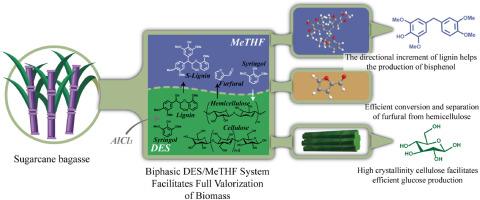Biphasic system and benign polymerization enable full utilization of biomass components
IF 5.8
2区 生物学
Q1 AGRICULTURAL ENGINEERING
引用次数: 0
Abstract
Achieving efficient enzymatic hydrolysis of cellulose and high-value lignin conversion requires overcoming lignin inhibition and condensation. This study presents a novel biphasic system comprising deep eutectic solvent (DES, choline chloride/p-toluenesulfonic acid) and 2-methyltetrahydrofuran (MeTHF), integrated with syringol (S-ol)-induced directional lignin addition catalyzed by AlCl3 for comprehensive biomass utilization. This system enables efficient fractionation of sugarcane bagasse, achieving over 95 % lignin removal under optimal conditions (80 °C, 1 h, DES(P-TSA:ChCl:AlCl3 = 1:1:0.1):MeTHF = 1:1, 0.3 g S-ol). The resulting cellulose residue exhibits a high lignin removal rate and enhanced enzymatic digestibility, yielding 757.9 mg/g glucose after 72 h of hydrolysis, a 3.5-fold increase compared to bagasse. Hemicellulose conversion to furfural is facilitated by the biphasic effect, with 69.73 % total yield (10.07 % in DES phase and 60.66 % in MeTHF phase), occurring at a lower temperature (80 °C) than conventional methods. Lignin modified by S-ol (S-lignin) accumulates in the MeTHF phase, forming low-molecular-weight S-lignin that produces 40.04 % bisphenol analogs via pyrolysis, showing potential as a sustainable substitute for fossil-based bisphenol A. This strategy integrates lignin directional transformation, cellulose protection, and hemicellulose conversion, providing a green pathway for full valorization of lignocellulosic biomass and promoting sustainable biorefinery development.

双相体系和良性聚合使生物质组分得到充分利用
实现纤维素的高效酶解和高价值木质素转化需要克服木质素的抑制和冷凝。本研究提出了一种新的双相体系,该体系由深度共熔溶剂(DES,氯化胆碱/对甲苯磺酸)和2-甲基四氢呋喃(MeTHF)组成,结合丁香醇(S-ol)诱导的AlCl3催化木质素定向加成,用于生物质的综合利用。该系统在最佳条件下(80°C, 1 h, DES(P-TSA:ChCl:AlCl3 = 1:1:0.1):MeTHF = 1:1, 0.3 g S-ol)实现了95%以上的木质素脱除。所得纤维素渣具有较高的木质素去除率和酶解率,水解72 h后葡萄糖产量为757.9 mg/g,比甘蔗渣提高3.5倍。双相效应促进了半纤维素向糠醛的转化,在较低的温度(80℃)下,总收率为69.73% (DES相10.07%,MeTHF相60.66%)。S-ol修饰的木质素(S-lignin)在MeTHF阶段积累,形成低分子量的s -木质素,通过热解产生40.04%的双酚类似物,具有作为化石基双酚a的可持续替代品的潜力。该策略集木质素定向转化、纤维素保护和半纤维素转化为一体,为木质纤维素生物质的全面增值提供了绿色途径,促进了生物炼制的可持续发展。
本文章由计算机程序翻译,如有差异,请以英文原文为准。
求助全文
约1分钟内获得全文
求助全文
来源期刊

Biomass & Bioenergy
工程技术-能源与燃料
CiteScore
11.50
自引率
3.30%
发文量
258
审稿时长
60 days
期刊介绍:
Biomass & Bioenergy is an international journal publishing original research papers and short communications, review articles and case studies on biological resources, chemical and biological processes, and biomass products for new renewable sources of energy and materials.
The scope of the journal extends to the environmental, management and economic aspects of biomass and bioenergy.
Key areas covered by the journal:
• Biomass: sources, energy crop production processes, genetic improvements, composition. Please note that research on these biomass subjects must be linked directly to bioenergy generation.
• Biological Residues: residues/rests from agricultural production, forestry and plantations (palm, sugar etc), processing industries, and municipal sources (MSW). Papers on the use of biomass residues through innovative processes/technological novelty and/or consideration of feedstock/system sustainability (or unsustainability) are welcomed. However waste treatment processes and pollution control or mitigation which are only tangentially related to bioenergy are not in the scope of the journal, as they are more suited to publications in the environmental arena. Papers that describe conventional waste streams (ie well described in existing literature) that do not empirically address ''new'' added value from the process are not suitable for submission to the journal.
• Bioenergy Processes: fermentations, thermochemical conversions, liquid and gaseous fuels, and petrochemical substitutes
• Bioenergy Utilization: direct combustion, gasification, electricity production, chemical processes, and by-product remediation
• Biomass and the Environment: carbon cycle, the net energy efficiency of bioenergy systems, assessment of sustainability, and biodiversity issues.
 求助内容:
求助内容: 应助结果提醒方式:
应助结果提醒方式:


